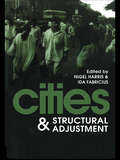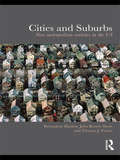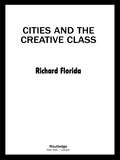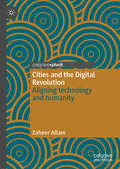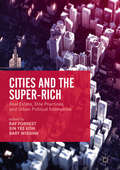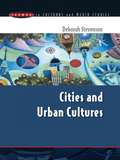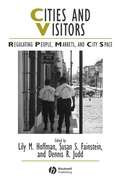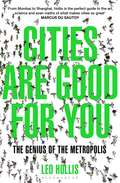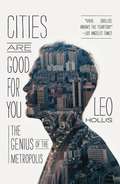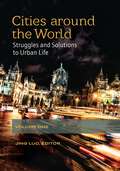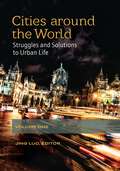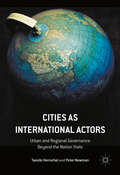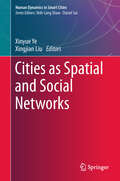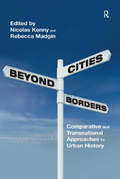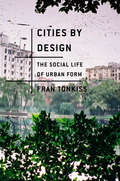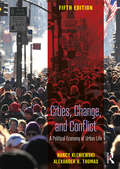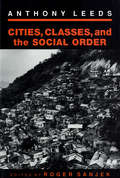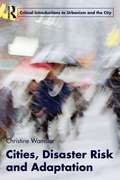- Table View
- List View
Cities And Structural Adjustment
by Nigel Harris Ida FabriciusThis work addresses the challenge faced in the management of major cities throughout the world as they adjust to economic reform and, in particular, to becoming more open to the processes operating in worldwide markets. Such processes have already had some dramatic effects on large cities in developed and developing countries - the rapid decline in manufacturing in older industrial cities and the emergence of the servicing city are but two of the more striking outcomes. Based on substantial case studies of cities in the developed and the developing world - Sheffield, Barcelona, Lille, Mexico City, Monterrey, Santiago de Chile, Bogota, Kingston Jamaica and Johannesburg - themes are drawn out, extending from structural economic change to policy reactions, new city initiatives, management, planning and finance.
Cities And Structural Adjustment
by Nigel Harris Ida FabriciusThis work addresses the challenge faced in the management of major cities throughout the world as they adjust to economic reform and, in particular, to becoming more open to the processes operating in worldwide markets. Such processes have already had some dramatic effects on large cities in developed and developing countries - the rapid decline in manufacturing in older industrial cities and the emergence of the servicing city are but two of the more striking outcomes. Based on substantial case studies of cities in the developed and the developing world - Sheffield, Barcelona, Lille, Mexico City, Monterrey, Santiago de Chile, Bogota, Kingston Jamaica and Johannesburg - themes are drawn out, extending from structural economic change to policy reactions, new city initiatives, management, planning and finance.
Cities and Suburbs: New Metropolitan Realities in the US
by Bernadette Hanlon John Rennie Short Thomas J. VicinoThis book is a systematic examination of the historical and current roles that cities and suburbs play in US metropolitan areas. It explores the history of cities and suburbs, their changing dynamics with each other, their growing diversity, the environmental consequences of their development and finally the extent and nature of their decline and renewal. Cities and Suburbs: New Metropolitan Realities in the US offers a comprehensive examination of demographic and socioeconomic processes of US suburbanization by providing a succinct guide to understanding the dynamic relationship between metropolitan structure and processes of social change. A variety of case studies are used in the chapters to explore suburban successes and failures and the discourse concludes with reflections on metropolitan policy and planning for the twenty-first century. The topics of discussion include: Key ideas and concepts on the demographic and sociospatial aspects of metropolitan change The changing nature of city and suburban population migration and their relationships with changes at the local, metropolitan, national, and global levels Current metropolitan public policy issues of large cities and suburbs Links of suburbanization to metropolitan transformation and the growing dichotomy between suburban decline and suburban sprawl in metropolitan areas. Cities and Suburbs relies on theorized case studies, demographic analysis, maps, and photos from North America. Written in a clear and accessible style, the book addresses various fundamental questions about the socioeconomic role that suburbs and cities play in shaping metropolitan areas, their environmental impact, the political consequences, and the resulting policy debates. This is essential reading for scholars and students of Geography, Economics, Politics, Sociology, Urban Studies and Urban Planning.
Cities and Suburbs: New Metropolitan Realities in the US
by Bernadette Hanlon John Rennie Short Thomas J. VicinoThis book is a systematic examination of the historical and current roles that cities and suburbs play in US metropolitan areas. It explores the history of cities and suburbs, their changing dynamics with each other, their growing diversity, the environmental consequences of their development and finally the extent and nature of their decline and renewal. Cities and Suburbs: New Metropolitan Realities in the US offers a comprehensive examination of demographic and socioeconomic processes of US suburbanization by providing a succinct guide to understanding the dynamic relationship between metropolitan structure and processes of social change. A variety of case studies are used in the chapters to explore suburban successes and failures and the discourse concludes with reflections on metropolitan policy and planning for the twenty-first century. The topics of discussion include: Key ideas and concepts on the demographic and sociospatial aspects of metropolitan change The changing nature of city and suburban population migration and their relationships with changes at the local, metropolitan, national, and global levels Current metropolitan public policy issues of large cities and suburbs Links of suburbanization to metropolitan transformation and the growing dichotomy between suburban decline and suburban sprawl in metropolitan areas. Cities and Suburbs relies on theorized case studies, demographic analysis, maps, and photos from North America. Written in a clear and accessible style, the book addresses various fundamental questions about the socioeconomic role that suburbs and cities play in shaping metropolitan areas, their environmental impact, the political consequences, and the resulting policy debates. This is essential reading for scholars and students of Geography, Economics, Politics, Sociology, Urban Studies and Urban Planning.
Cities and the Creative Class
by Richard FloridaIn his compelling follow-up to The Rise of the Creative Class, Richard Florida outlines how certain cities succeed in attracting members of the 'creative class' - the millions of people who work in information-age economic sectors and in industries driven by innovation and talent.
Cities and the Creative Class (Regions And Cities Ser.)
by Richard FloridaIn his compelling follow-up to The Rise of the Creative Class, Richard Florida outlines how certain cities succeed in attracting members of the 'creative class' - the millions of people who work in information-age economic sectors and in industries driven by innovation and talent.
Cities and the Digital Revolution: Aligning technology and humanity
by Zaheer AllamThis book explores the emergence and development of data in cities. It exposes how Information Communication Technology (ICT) corporations seeking to capitalize on cities developing needs for urban technologies have contributed to many of the issues we are faced with today, including urbanization, centralization of wealth and climate change. Using several case studies, the book provides examples of the, in part, detrimental effects ICT driven ‘Smart City’ solutions have had and will have on the human characteristics that contribute to the identity and sense of belonging innate to many of our cities. The rise in Artificial Intelligence, Big Data, and technologies like social media, has changed how people interact with and in cities, and Allam discusses of how these changes require planners, engineers and other urban professionals to adjust their approach. The main question the book seeks to address is ‘how can we use emerging technologies to recalibrate our cities and ensure increased livability, whilst also effectively dealing with their associate challenges?’ This is an ongoing conversation, but one that requires extensive thought as it has extensive consequences. This book will be of interest to students, academics, professionals and policy makers across a broad range of subjects including urban studies, architecture and STS, geography and social policy.
Cities and the Super-Rich: Real Estate, Elite Practices and Urban Political Economies (The Contemporary City)
by Sin Yee Koh Ray Forrest Bart WissinkWith the rise of wealth inequalities, our cities are changing dramatically. This collection critically engages with and advances existing debates on the super-rich and their roles in these transformations. An interdisciplinary range of contributions from international experts including sociologists, geographers, historians, discourse analysts, and urban studies specialists reveal crucial aspects of the real estate investment practices of the super-rich, their social spaces in the city as well as the distinct influence of the super-rich on the transformation of four key cities: London, Tokyo, Singapore and Hong Kong. By drawing together diverse disciplines, perspectives, and experiences across different geographical contexts, this book offers a fresh, comparative, and nuanced take on the super-rich and the 1% city, as well as a solid, empirically and theoretically grounded basis to think about future research questions and policy implications.
Cities and Urban Cultures (UK Higher Education OUP Humanities & Social Sciences Media, Film & Cultural Studies)
by Deborah Stevenson*What is distinctive about urban life?*What key trends have shaped the contemporary city?*How have the city and urban cultures been explained by sociology and cultural studies?This is the first book to explore cities and urban life from the perspectives of both sociology and cultural theory. Through an interdisciplinary approach and use of case material, the book demonstrates that the 'real' city of physicality and struggle and the 'imagined' city of representations are entwined in the construction of urban cultures.Starting with a comparison of the rural and the urban, the book considers ways of imagining the city and of conceptualising urban cultures. It goes on to investigate the implications of several pivotal urban and cultural trends, such as the use of the arts and local cultures in city re-imaging, and the ways in which modernism, postmodernism and globalisation have shaped the built environment and the orientation of academic enquiry. Also examined is the way in which representations of the urban landscape in film, literature, art, and popular texts, have informed dominant ideas about the way certain city spaces - including city centres, urban waterfronts, and so-called 'global cities' - should look, function and 'feel'.Designed as a text for undergraduate courses in cultural studies, sociology and wider social science, this book traces the development of urban environments from the nineteenth century to the present, and illuminates the nature of urban life.
Cities and Visitors: Regulating People, Markets, and City Space (IJURR Studies in Urban and Social Change Book Series #57)
by Lily M. HoffmanThe authors of this book use regulation theory to bring theoretical focus and analytic clarity to the study of urban tourism. Provides a unifying analytic framework for the study of urban tourism. Brings urban tourism into focus as an important political, economic and cultural phenomenon. Presents original essays written by established scholars, including studies of Venice, Mexico, Montreal, New York, Los Angeles, London, Barcelona, Berlin, Amsterdam, Paris, and Australia's Gold Coast.
Cities and Visitors: Regulating People, Markets, and City Space (IJURR Studies in Urban and Social Change Book Series)
by Lily M. Hoffman Susan S. Fainstein Dennis R. JuddThe authors of this book use regulation theory to bring theoretical focus and analytic clarity to the study of urban tourism. Provides a unifying analytic framework for the study of urban tourism. Brings urban tourism into focus as an important political, economic and cultural phenomenon. Presents original essays written by established scholars, including studies of Venice, Mexico, Montreal, New York, Los Angeles, London, Barcelona, Berlin, Amsterdam, Paris, and Australia's Gold Coast.
Cities Are Good for You: The Genius of the Metropolis
by Leo HollisThe 21st century will be the age of the city. Already over 50% of the world population live in urban centres and over the coming decades this percentage will increase. Blending anecdote, fact and first hand encounters - from exploring the slums of Mumbai, to visiting roof-top farms in Brooklyn and attending secret dinner parties in Paris, to riding the bus in Latin America - Leo Hollis reveals that we have misunderstood how cities work for too long. Upending long-held assumptions and challenging accepted wisdom, he explores: why cities can never be rational, organised places; how we can walk in a crowd without bumping into people, and if we can design places that make people want to kiss; whether we have the right solution to the problem of the slums; how ants, slime mould and traffic jams can make us rethink congestion. And above all, the unexpected reasons why living in the city can make us fitter, richer, smarter, greener, more creative - and, perhaps, even happier. Cities Are Good for You introduces dreamers, planners, revolutionaries, writers, scientists, architects, slum-dwellers and emperors. It is shaped by the idea that cities are the greatest social experiment in human history, built for people, and by the people.
Cities Are Good for You: The Genius of the Metropolis
by Leo HollisCities are where the twenty-first century is really going to happen. Already at the beginning of the century, we became 50% urban as a global population, and by 2050 we're going to be up to 70% urban. So cities could either be our coffin or our ark. Leo Hollis presents evidence that cities can deliver a better life and a better world in the future. From exploring what slime mold can tell us about traffic flow, to looking at how traditional civic power structures are being overturned by Twitter, to investigating how cities all over the world are tackling climate change, population growth, poverty, shifting work patterns and the maintenance of the fragile trust of their citizens, Cities Are Good for You offers a new perspective on the city.Combining anecdote, scientific studies, historical portraits, first-hand interviews and observations of some of the most exciting world cities, Hollis upends long-held assumptions with new questions: Where do cities come from? Can we build a city from scratch? Does living in the city make you happier or fitter? Is the metropolis of the future female? What is the relationship between cities and creativity? And are slums really all that bad? Cities Are Good for You introduces us to dreamers, planners, revolutionaries, writers, scientists, architects, slum-dwellers and kings. Ranging globally and through time in search of answers--from the archive to the laboratory, from City Hall to the architect's desk--it is above all driven by the idea that cities are for people and by people.
Cities around the World [2 volumes]: Struggles and Solutions to Urban Life [2 volumes]
by Jing LuoThis two-volume set offers a comprehensive overview of major challenges faced by cities worldwide in the 21st century, and how cities in different geographic, economic, and political conditions are finding solutions to them.This two-volume encyclopedia examines ten critical issues that face cities across the globe today—environmental and societal struggles that affect the daily lives of city dwellers. Readers will gain a better understanding of our global neighbors and will be able to use this book in order to compare and contrast different approaches to critical issues in our world. Volume One examines employment and jobs; energy and sustainability; green spaces; housing and infrastructure; and migration and demographic changes. Volume Two discusses pollution; schools; traffic and transportation; violence, corruption, and organized crime; and waste management. Each issue begins with an introduction providing an overview of the issue from a global perspective. Following the introduction are ten alphabetically arranged world city profiles of cities that are struggling with the issue and cities that have found innovative solutions to deal with the crisis. The profiles explain how the problem came to be; consequences inhabitants face, such as compromised health, limited access to education, and high taxes with low wages; and failed and successful initiatives taken by city management.
Cities around the World [2 volumes]: Struggles and Solutions to Urban Life [2 volumes]
This two-volume set offers a comprehensive overview of major challenges faced by cities worldwide in the 21st century, and how cities in different geographic, economic, and political conditions are finding solutions to them.This two-volume encyclopedia examines ten critical issues that face cities across the globe today—environmental and societal struggles that affect the daily lives of city dwellers. Readers will gain a better understanding of our global neighbors and will be able to use this book in order to compare and contrast different approaches to critical issues in our world. Volume One examines employment and jobs; energy and sustainability; green spaces; housing and infrastructure; and migration and demographic changes. Volume Two discusses pollution; schools; traffic and transportation; violence, corruption, and organized crime; and waste management. Each issue begins with an introduction providing an overview of the issue from a global perspective. Following the introduction are ten alphabetically arranged world city profiles of cities that are struggling with the issue and cities that have found innovative solutions to deal with the crisis. The profiles explain how the problem came to be; consequences inhabitants face, such as compromised health, limited access to education, and high taxes with low wages; and failed and successful initiatives taken by city management.
Cities as International Actors: Urban and Regional Governance Beyond the Nation State
by Peter Newman Tassilo HerrschelThis book explores the growing role of cities and regions as sub-national actors in shaping global governance. Far from being merely carried along by global forces, cities have become active players in making and maintaining the networks and connections that give shape to contemporary globalization. Exploring examples from Europe, North America and beyond, the authors reconcile the two separate, yet complimentary, theoretical and analytical lenses adopted by Urban Studies and International Relations, as they address the nature of ‘cities’ and ‘internationality’. The authors challenge academic debate that is reluctant to cross disciplinary boundaries and thus offer more relevant answers to the new phenomenon of international city action, and how it weakens the traditional prerogative of the state as primary actor in the international realm. Conclusions focus on how this new internationality opens opportunities for cities and regions but also contains potential pitfalls that can constrain policy options and challenge the legitimacy of policy making at all scales.
Cities as Spatial and Social Networks (Human Dynamics in Smart Cities)
by Xinyue Ye Xingjian LiuThis book reports on the latest, cutting-edge scholarship on integrating social network and spatial analyses in the built environment. It sheds light on conceptualization and Implementation of such integration, integration for intra-city level analysis, as well as integration for inter-city level analysis. It explores the use of new data sources concerning human and urban dynamics and provides a discussion of how social network and spatial analyses could be synthesized for a more nuanced understanding of the built environment. As such this book will be a valuable resource for scholars focusing on city-related networks in a number of ‘urban’ disciplines, including but not limited to urban geography, urban informatics, urban planning, urban sociology, and urban studies.
Cities Beyond Borders: Comparative and Transnational Approaches to Urban History
by Nicolas Kenny Rebecca MadginDrawing on a body of research covering primarily Europe and the Americas, but stretching also to Asia and Africa, from the mid-eighteenth century to the present, this book explores the methodological and heuristic implications of studying cities in relation to one another. Moving fluidly between comparative and transnational methods, as well as across regional and national lines, the contributors to this volume demonstrate the necessity of this broader view in assessing not just the fundamentals of urban life, the way cities are occupied and organised on a daily basis, but also the urban mindscape, the way cities are imagined and represented. In doing so the volume provides valuable insights into the advantages and limitations of using multiple cities to form historical inquiries.
Cities Beyond Borders: Comparative and Transnational Approaches to Urban History
by Nicolas Kenny Rebecca MadginDrawing on a body of research covering primarily Europe and the Americas, but stretching also to Asia and Africa, from the mid-eighteenth century to the present, this book explores the methodological and heuristic implications of studying cities in relation to one another. Moving fluidly between comparative and transnational methods, as well as across regional and national lines, the contributors to this volume demonstrate the necessity of this broader view in assessing not just the fundamentals of urban life, the way cities are occupied and organised on a daily basis, but also the urban mindscape, the way cities are imagined and represented. In doing so the volume provides valuable insights into the advantages and limitations of using multiple cities to form historical inquiries.
Cities by Design: The Social Life of Urban Form
by Fran TonkissWho makes our cities, and what part do everyday users have in the design of cities? This book powerfully shows that city-making is a social process and examines the close relationship between the social and physical shaping of urban environments. With cities taking a growing share of the global population, urban forms and urban experience are crucial for understanding social injustice, economic inequality and environmental challenges. Current processes of urbanization too often contribute to intensifying these problems; cities, likewise, will be central to the solutions to such problems. Focusing on a range of cities in developed and developing contexts, Cities by Design highlights major aspects of contemporary urbanization: urban growth, density and sustainability; inequality, segregation and diversity; informality, environment and infrastructure. Offering keen insights into how the shaping of our cities is shaping our lives, Cities by Design provides a critical exploration of key issues and debates that will be invaluable to students and scholars in sociology and geography, environmental and urban studies, architecture, urban design and planning.
Cities, Change, and Conflict: A Political Economy of Urban Life (Sociology Ser.)
by Nancy Kleniewski Alexander R. ThomasCities, Change, and Conflict was one of the first texts to embrace the perspective of political economy as its main explanatory framework, and then complement it with the rich contributions found in the human ecology perspective. Although its primary focus is on North American cities, the book contains several chapters on cities in other parts of the world, including Europe and developing nations, providing both historical and contemporary accounts on the impact of globalization on urban development. This edition features new coverage of important recent developments affecting urban life, including the implications of racial conflict in Ferguson, Missouri , and elsewhere, recent presidential urban strategies, the new waves of European refugees, the long-term impacts of the Great Recession as seen through the lens of Detroit’s bankruptcy, new and emerging inequalities, and an extended look into Sampson’s Great American City. Beyond examining the dynamics that shape the form and functionality of cities, the text surveys the experience of urban life among different social groups, including immigrants, African Americans,women, and members of different social classes. It illuminates the workings of the urban economy, local and federal governments, and the criminal justice system, and also addresses policy debates and decisions that affect almost every aspect of urbanization and urban life.
Cities, Change, and Conflict: A Political Economy of Urban Life
by Nancy Kleniewski Alexander R. ThomasCities, Change, and Conflict was one of the first texts to embrace the perspective of political economy as its main explanatory framework, and then complement it with the rich contributions found in the human ecology perspective. Although its primary focus is on North American cities, the book contains several chapters on cities in other parts of the world, including Europe and developing nations, providing both historical and contemporary accounts on the impact of globalization on urban development. This edition features new coverage of important recent developments affecting urban life, including the implications of racial conflict in Ferguson, Missouri , and elsewhere, recent presidential urban strategies, the new waves of European refugees, the long-term impacts of the Great Recession as seen through the lens of Detroit’s bankruptcy, new and emerging inequalities, and an extended look into Sampson’s Great American City. Beyond examining the dynamics that shape the form and functionality of cities, the text surveys the experience of urban life among different social groups, including immigrants, African Americans,women, and members of different social classes. It illuminates the workings of the urban economy, local and federal governments, and the criminal justice system, and also addresses policy debates and decisions that affect almost every aspect of urbanization and urban life.
Cities, Classes, and the Social Order (The Anthropology of Contemporary Issues)
by Anthony LeeCities, Classes, and the Social Order brings together nine conceptual and theoretical essays by the anthropologist, Anthony Leeds (1925–1989), whose pioneering work in the anthropology of complex societies was built on formative personal and research experiences in both urban and rural settings in the United States, Brazil, Venezuela, and Portugal.Leeds brought to his anthropology a simultaneous concern for science and humanism, and for explanation and interpretation. He constructed a nuanced and intricate vision of the connections among ecology, technology, history, evolution, structure, process, power, culture, social organization, and human creativity. The essays in this book draw on his approach to demarcate the role of cities in human history, the use and abuse of class analysis, the bases of power in complex societies, and an agenda for ethnographic and social-historical research in the contemporary world.In addition to major but little-known writings and an important essay on Marx here published for the first time in English, a selection of Leeds's ethnographically and politically inspired poems are included, as are several of his professionally exhibited photographs. In addition, introductory essays by R. Timothy Sieber and Roger Sanjek chart the course of Leeds's career and the development of his theoretical viewpoint.
Cities, Disaster Risk and Adaptation
by Christine WamslerWorldwide, disasters and climate change pose a serious risk to sustainable urban development, resulting in escalating human and economic costs. Consequently, city authorities and other urban actors face the challenge of integrating risk reduction and adaptation strategies into their work. However, related knowledge and expertise are still scarce and fragmented. Cities, Disaster Risk and Adaptation explores ways in which resilient cities can be ‘built’ and sustainable urban transformations achieved. The book provides a comprehensive understanding of urban risk reduction and adaptation planning, exploring key theoretical concepts and analysing the complex interrelations between cities, disasters and climate change. Furthermore, it provides an overview of current risk reduction and adaptation approaches taken by both city authorities and city dwellers from diverse contexts in low, middle and high income nations. Finally, the book offers a planning framework for reducing and adapting to risk in urban areas by expanding on pre-existing positive actions and addressing current shortfalls in theory and practice. The importance of a distributed urban governance system, in which institutions’ and citizens’ adaptive capacities can support and complement each other, is highlighted. This book takes a holistic approach; it integrates perspectives and practice from risk reduction and climate change adaptation based on a specific urban viewpoint. The text is richly supplemented with boxed case studies written by renowned academics and practitioners in the field and ‘test yourself’ scenarios that integrate theory into practice. Each chapter contains learning objectives, end of chapter questions, suggested further reading and web resources, as well as a wealth of tables and figures. This book is essential reading for undergraduate and postgraduate students of geography, urban studies and planning, architecture, environmental studies, international development, sociology and sustainability studies.
Cities, Disaster Risk and Adaptation
by Christine WamslerWorldwide, disasters and climate change pose a serious risk to sustainable urban development, resulting in escalating human and economic costs. Consequently, city authorities and other urban actors face the challenge of integrating risk reduction and adaptation strategies into their work. However, related knowledge and expertise are still scarce and fragmented. Cities, Disaster Risk and Adaptation explores ways in which resilient cities can be ‘built’ and sustainable urban transformations achieved. The book provides a comprehensive understanding of urban risk reduction and adaptation planning, exploring key theoretical concepts and analysing the complex interrelations between cities, disasters and climate change. Furthermore, it provides an overview of current risk reduction and adaptation approaches taken by both city authorities and city dwellers from diverse contexts in low, middle and high income nations. Finally, the book offers a planning framework for reducing and adapting to risk in urban areas by expanding on pre-existing positive actions and addressing current shortfalls in theory and practice. The importance of a distributed urban governance system, in which institutions’ and citizens’ adaptive capacities can support and complement each other, is highlighted. This book takes a holistic approach; it integrates perspectives and practice from risk reduction and climate change adaptation based on a specific urban viewpoint. The text is richly supplemented with boxed case studies written by renowned academics and practitioners in the field and ‘test yourself’ scenarios that integrate theory into practice. Each chapter contains learning objectives, end of chapter questions, suggested further reading and web resources, as well as a wealth of tables and figures. This book is essential reading for undergraduate and postgraduate students of geography, urban studies and planning, architecture, environmental studies, international development, sociology and sustainability studies.
